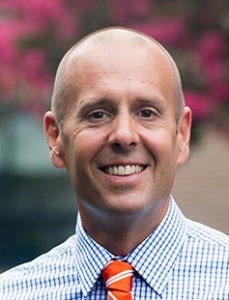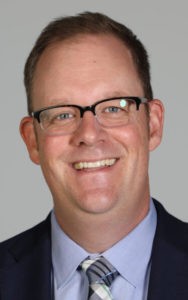This is the fourth in a series created by a partnership between Baptist News Global and the Campbell University Center for Church and Community. Each month’s columns explore one of the seven types of capital described in the Community Capitals Framework developed by Flora, Flora and Gasteyer.
Part of Brian’s background includes two decades as a minister working with students and their families. One of the challenging parts of that work often was finding adult volunteers to participate in the ministry. There were some days it felt like pulling teeth just to find warm bodies to chaperone a retreat, lead a Bible study or provide a Sunday night meal.
“He never saw a volunteer as a warm body again.”
A turning point occurred when Brian asked a church member about volunteering to help. The person responded with an innocent but insightful question, “Can you tell me what it is you would like me to do, and why you think I’m the right person to ask?”
In that question, Brian’s approach to how he saw volunteers changed. He never saw a volunteer as a warm body again. Rather than valuing people merely for their presence, it was about recognizing the capital each one represented.

(123rf.com)
Flora, Flora and Gasteyer posit that “human capital consists of the assets each person possesses: health, formal education, skills, knowledge, leadership and potential.” After that experience, Brian asked each volunteer to participate based on how their gifts or talents matched the needs of the event or function of ministry. In other words, their individual human capital was recognized, affirmed and nurtured as part of ministry.
Just as Brian’s perspective on “volunteers as capital” changed, there also is a need for congregations to redefine how they understand human capital in their communities.
“Although the dominant cultural capital tends to define human capital in terms of formal learning, human capital is far more than educational attainment,” according to Flora, Flora and Gasteyer.
Human capital also is deeply connected to health and human thriving, which extends far beyond an individual’s educational status. Thriving is a community health issue as much as it is an individual one.
As congregations see the deep connection between health and human capital, it challenges and alters how we define neighbor. This is particularly true when recalling the words of Paul, that “if one part of the body suffers, the whole body suffers.” When we overlook the needs of the most vulnerable, we are allowing a sizeable part of the body to suffer.
Consider those in the congregation and community who lacked access to food, faced eviction or risked their health in public-facing jobs during the pandemic while many others worked from home, found greater work-life balance and accessed goods they needed (or wanted) through Amazon. Many faced little suffering during the pandemic while others are still facing epic disruption in their lives.
Once again, these are public health and human capital issues that impact human and community thriving. How do we recognize these inequalities in the work of the church while supporting members where they are?
“Once vaccines became available, it was clear that small towns have a unique skill set for distribution.”
One place to examine this is situated in this era of COVID-19 and rural communities. Once vaccines became available, it was clear that small towns have a unique skill set for distribution. Harnett County, N.C., is home to Campbell University and was highlighted early on as a community that was one to watch for vaccine distribution. The Raleigh News & Observer featured the county distribution as a model of efficiency. The article demonstrates how non-metro counties were doing better at distribution early on. Part of the reason is an unseen network of hospitality and in-person connectivity as a primary means of communication. Technology serves us all well, but it is a helpful reminder that human connection and passion serve us equally, if not better, sometimes.
Despite this success, “rural Americans face a unique combination of factors that create disparities in health care not found in urban areas,” which may include economic, political and geographic impediments to health services (Flora et al.). These disparities have been an impediment to rural health for some time, but the COVID pandemic also had an outsized effect on rural communities. Statistics from the USDA indicate “rural (non-metro) residents are more vulnerable to severe illness or death from COVID-19 than urban (metro) residents because of factors such as underlying health problems, older age and lack of health insurance.” This is part of a larger trend highlighting the thin line of survival for rural access to hospitals and health care. The pandemic is doing damage in communities to these structures as well.
Time magazine recently featured an article about the devastation wrought on hospitals in rural areas by multiple waves of the pandemic. The American Hospital Association reports even more alarming numbers about the role of the pandemic on hospitals in rural areas, and the ability of rural Americans to have access to high-quality health care. A shortage of physicians highlights the need to prepare physicians, but also teachers and business leaders, to work in rural communities.
There are going to be multiple industries impacted by the pandemic and the unique needs of rural communities. These are shortages that must be addressed. This is very much a human capital and health issue that points directly to whether or not a community can thrive.
“The small-town church is about far more than just spiritual well-being.”
For one mom Brian spoke to recently, the small-town church is about far more than just spiritual well-being. While that is often a priority, she expressed a more holistic connection. It is this very holistic connection that is the lifeblood of rural and small towns, and perhaps a reason why we need to recognize the role of health in human thriving as essential to building and maintaining human capital. Using Maslow’s hierarchy of needs suggests we focus on filling a hole in the basic physiological and safety needs of people and communities before we can focus on the spiritual.
“Human capital includes those attributes of individuals that contribute to their ability to earn a living, strengthen community and otherwise contribute to community organizations, their families and self-improvement.” (Flora et al.). Congregations can become a central rallying point for community health concerns and resources.
To bring back an earlier point, let’s value people, not merely for their presence, rather recognizing the capital each one represents for a flourishing community.
An example of this comes from our friend Daniel Pryfogle from Sympara, who tells a story of when he served as interim pastor of a church in Austin, Texas. University of Texas undergrads were experiencing a mental health crisis that overwhelmed the campus counselors. Congregations and ministries surrounding the campus began to examine their human capital, acknowledging the mental health specialists among them. The ministries concluded they could start or expand counseling services to alleviate the crisis at the university. When considering stories like this one from Austin and how you view your congregation’s human capital, where can you begin leading initiatives for thriving in your community?
Here are some ideas for consideration in your congregation:
- Become a vaccination site or provide members resources and transportation.
- Advocate for rural health care providers in your area.
- Start a community garden project or food co-op with local farmers to focus on food insecurity.
- Have congregational conversations built around these questions:
- How can our congregation assess the skills of our volunteers to get people in the right places?
- How does the local environment (natural capital) impact health?
- How does cultural capital, like the ability to communicate with health service providers, impact health? Who can help with language barriers?
- What do we do about health and human capital after the pandemic too?

Brian Foreman

Justin Nelson
Brian Foreman serves as executive director of the Center for Church and Community at Campbell University. Justin J. Nelson serves as assistant professor of sociology.
Previous articles in this series:
Let’s begin a conversation about the church in rural areas
The importance of natural capital for the rural church
Rural churches need to understand the cultural capital of their communities


